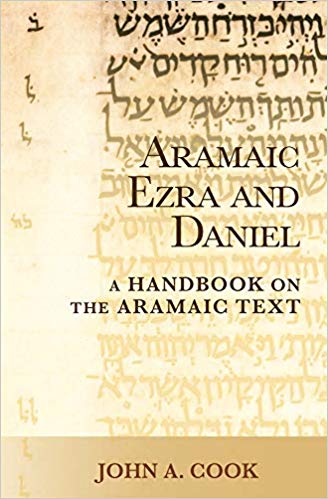A Book Review from Books At a Glance
By Eric Tully
It is as important as ever to read and exegete the Old Testament text in its original languages, and we have more tools than ever to assist us. For many of us, outstanding reference grammars, Bible software, commentaries, journal articles, and monographs are only a click away. However, some of us do not have the linguistic background to make use of this disparate information in our studies, while others of us do not have the time to do so comprehensively in an entire book or corpus. Technical commentaries are invaluable, but they are selective in addressing linguistic issues. On the other hand, expositional commentaries get straight to the exegetical payoff without “showing their work.” Baylor University Press’ successful series, “Handbook on the Hebrew Bible,” fills an important niche by providing expert, comprehensive guidance on the Old Testament text itself. These linguistic commentaries build a foundation for the study of the Old Testament in Hebrew by explaining the form and syntax of the biblical text, guiding the reader through semantic analyses, highlighting features with exegetical significance, and providing guidance in text-critical debates.
There are now twelve volumes in the series: Genesis 1-11 (Bandstra 2008), Amos (Garrett 2008), Ruth (Holmstedt 2010), Malachi (Eddinger 2012), Genesis 37-50 (Baker and Rily 2014), Esther (Screnock and Holmstedt 2015), Deuteronomy 1-11 (Robson 2016), Haggai and Zechariah 1-8 (Rogland 2016), Qoheleth (Holmstedt, Cook, and Marshall 2017), Hosea (Tully 2018) and a new edition of Jonah (Tucker 2018, revised edition).
John Cook’s Aramaic Ezra and Daniel (2019), the volume under review, is unique in the series because it is a “Handbook on the Aramaic Text.” Cook is Professor of Old Testament and Director of Hebrew Language Instruction at Asbury Theological Seminary and a Research Fellow at the University of the Free State in Bloemfontein, South Africa. He has written extensively on modern linguistic approaches to Biblical Hebrew, including numerous journal articles, a significant monograph on the semantics of the Hebrew verbal system, Time and the Biblical Hebrew Verb (Eisenbrauns, 2012), a teaching grammar of Biblical Hebrew, Beginning Biblical Hebrew (Baker Academic, 2013, co-authored with Holmstedt) and the Qoheleth volume in the present series (co-authored with Holmstedt and Marshall, 2017).
Aramaic Ezra and Daniel consists of an introduction, textual commentary, glossary of linguistic terms, bibliography, and an index of linguistic issues. In the first part of the commentary, Cook treats the Aramaic passages of Ezra 4:8-6:18 and 7:12-26. In the second part, he treats the Aramaic in Daniel 2; 3:1-30; 3:31-4:34; 5:1-6:1; 6:2-29 and Daniel 7. He also treats the Hebrew text in these literary units as well in Ezra 4:1-7 and 7:1-11 and Daniel 2:1-4a.
Due to the focused aim of the volume as well as its technical nature, the Introduction (26 pages) is designed to familiarize the reader with the linguistic terminology and concepts used in the commentary. The approach to word order and the verbal system reflects Cook’s previous scholarship and works, grounded in generative grammar. Cook offers a brief primer on linguistic concepts such as constituents and hierarchy, valency, semantics (including the main verbal conjugations), and basic word order. He argues that Biblical Aramaic has a basic and underlying SVO word order which has been influenced toward a particularly SOV ordering [15]. The introduction also deals with the syntax of the primary relative particle, the Ketiv-Qere occurrences, vocabularly, and the Greek versions.
The commentary of each textual unit begins with a short introduction to literary features and dating, followed by a summary and translation of the unit. Cook then provides clause-by-clause analysis in which he parses the verbs, explains syntactic roles, describes the function of conjunctions and prepositions, identifies antecedents of pronouns, and offers guidance on translation. He also provides interpretive comments and some discussion of the historical context. Readers should not expect much, if any, literary or theological commentary. The commentary is restricted to the linguistic meaning of the Hebrew text. However, this narrow focus allows for comprehensive, foundational analysis which is the unique contribution of this series.
Cook takes a moderately critical stance on some issues. He argues that the Aramaic of Daniel is later than Ezra and comes from 200 BC-200 AD [1]. In the introduction to Daniel 2:13-23, he makes a brief case that the passage is a later insertion, a fact which he says explains some tensions and problems in the narrative [129]. He also follows John Collins in the view that the vision in Daniel 7 is an adaptation of Canaanite mythology and is intelligible against that background [277]. These and similar statements are given as background and do not have any bearing on the linguistics discussion which is central.
Aramaic Ezra and Daniel provides up-to-date, sophisticated linguistic analysis and explanation from one of the top scholars in the field. Although readers with some background in Aramaic will gain the most, even those with only a knowledge of Hebrew will benefit, due to the similarities between the two languages. The Aramaic portions of the Old Testament are frequently neglected in the original languages, and this volume represents an outstanding point of entry. It is highly recommended for those teaching or taking graduate-level courses in Biblical Aramaic, those studying Ezra or Daniel, and those preaching these books who want access to the riches of the original Aramaic text, led by a capable guide.
Eric J. Tully is Associate Professor of Old Testament and Semitic Languages at Trinity Evangelical Divinity School and Old Testament Book Review Editor at Books at a Glance.
Buy the books

ARAMAIC EZRA AND DANIEL: A HANDBOOK ON THE ARAMAIC TEXT, by John A. Cook